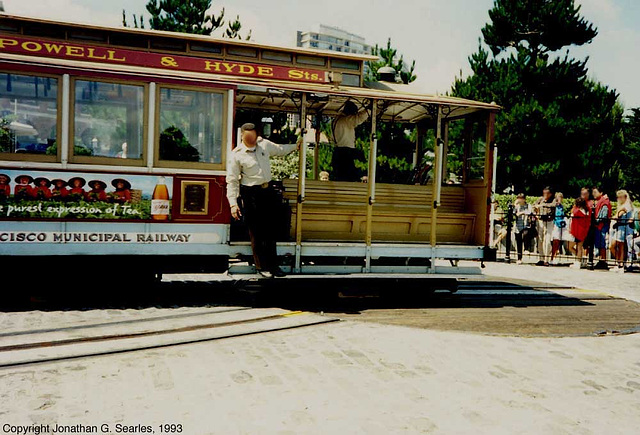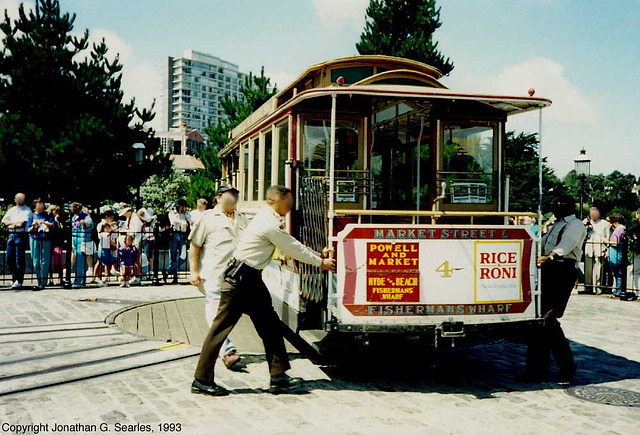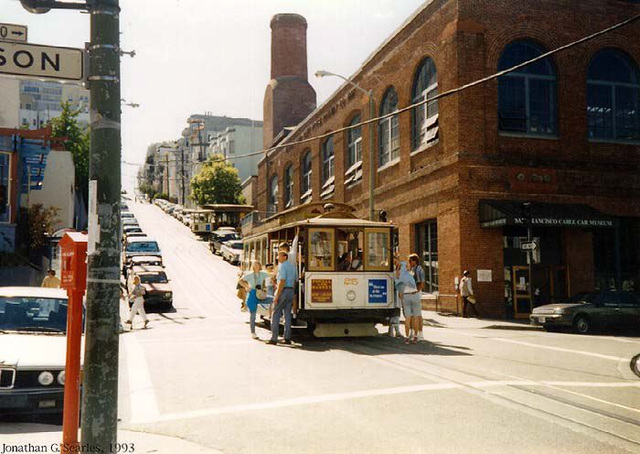
San Francisco
"Go to San Francis...cOouho! Hotcha!" :-)
01 Sep 2007
Cable Car On Turntable At Beach, Picture 1, San Francisco, CA, USA, 1993
The Cable Cars of the San Francisco Municipal Railway Powell & Hyde Line run from the corner of Powell and Market Streets to Beach, which is actually a beach on San Francisco Bay rather than on the Pacific Ocean, near Aquatic Park. There, a turntable allows them to change direction, as they aren't uni-directional. The momentum of the moving cable car rolls it onto the turntable, as seen in Picture 1, the cable car is turned by hand, as in Pictures 2 and 3, and then the car is pushed back onto the active track, only for the opposite direction. It can then be reconnected to the cable upon departure.
01 Sep 2007
Cable Car On Turntable At Beach, Picture 2, San Francisco, CA, USA, 1993
The Cable Cars of the San Francisco Municipal Railway Powell & Hyde Line run from the corner of Powell and Market Streets to Beach, which is actually a beach on San Francisco Bay rather than on the Pacific Ocean, near Aquatic Park. There, a turntable allows them to change direction, as they aren't uni-directional. The momentum of the moving cable car rolls it onto the turntable, as seen in Picture 1, the cable car is turned by hand, as in Pictures 2 and 3, and then the car is pushed back onto the active track, only for the opposite direction. It can then be reconnected to the cable upon departure.
01 Sep 2007
Cable Car On Turntable At Beach, Picture 3, San Francisco, CA, USA, 1993
The Cable Cars of the San Francisco Municipal Railway Powell & Hyde Line run from the corner of Powell and Market Streets to Beach, which is actually a beach on San Francisco Bay rather than on the Pacific Ocean, near Aquatic Park. There, a turntable allows them to change direction, as they aren't uni-directional. The momentum of the moving cable car rolls it onto the turntable, as seen in Picture 1, the cable car is turned by hand, as in Pictures 2 and 3, and then the car is pushed back onto the active track, only for the opposite direction. It can then be reconnected to the cable upon departure.
01 Sep 2007
View From Knob Hill, Picture 1, San Francisco, CA, USA, 1993
I took this from the top of Knob Hill in San Francisco, on my first (and for the moment only) trip to California. What's most striking about this photo to me is not so much the view (the detail is limited by the small size of the print I scanned AND the crude camera), but the massive low-lying cloud layer and fog which was enveloping S.F. on this very early morning. It was like this every morning, and people say that it's normal out there.
01 Sep 2007
View From Knob Hill, Picture 2, San Francisco, CA, USA, 1993
Here's a shot taken slightly later, as the fog began to clear, which gives a much prettier view of the city itself, of course.
01 Sep 2007
View From Knob Hill, Picture 3, San Francisco, CA, USA, 1993
This is more like Picture 1, but it has better composition, I think, incorporating the tourist facilities like a brochure. :-) Actually, at a normal time of day, and not super-early in the morning as here, it would probably be much more crowded, especially with cars, and not as pretty.
01 Sep 2007
San Francisco Bay, San Francisco, CA, USA, 1993
This is, according to rdsadie, a "beach area between the Presidio (on the left) and the marina. I didn't remember too much about it since I took it 1993 and uploaded it in 2007!!! :-)
01 Sep 2007
San Francisco Municipal Railway, Cable House, San Francisco, CA, USA, 1993
Cable Cars aren't universally considered trams. That's the purpose that they serve, though, for all practical purposes. The main thing that makes them different from others is that standard trams are powered through overhead cantenary that powers electric traction motors that power each axle, whereas Cable Cars are pulled along by a cable underneath the street. You can check out www.cablecarguy.com for more technical info. In any case, I got my chance to ride and photograph the San Francisco Municipal Railway, the last of the traditional Cable Car systems, in 1993. All of the other surviving systems operate on the less-standard "funicular system," used on steep hills. Unlike a standard cable car system, a funicular is limited by the fact that the cable is connected to both cars (all TWO! :-)) semi-permanently, so while one goes up the hill, the other goes down. This would never work in S.F., though, since it's a full-service system with many cars running on different streets. Therefore, the cables are controlled from a central cable house, pictured here on the right, which is also the San Francisco Cable Car Museum. The cars then can run semi-independently of the cable house's whims, controlling their access to the constantly moving cables under the street through the use of a "grip," that is sort of between a pliers and an automotive clutch. As such, cable car drivers are called "grip men (or perhaps women)."
Jump to top
RSS feed- Latest items - Subscribe to the latest items added to this album
- ipernity © 2007-2025
- Help & Contact
|
Club news
|
About ipernity
|
History |
ipernity Club & Prices |
Guide of good conduct
Donate | Group guidelines | Privacy policy | Terms of use | Statutes | In memoria -
Facebook
Twitter









